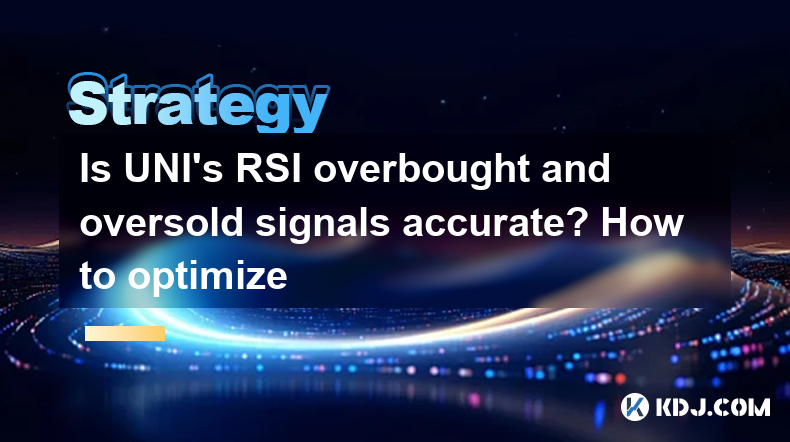-
 bitcoin
bitcoin $122025.899241 USD
-2.12% -
 ethereum
ethereum $4488.068729 USD
-4.11% -
 bnb
bnb $1315.348019 USD
8.65% -
 tether
tether $1.000457 USD
0.03% -
 xrp
xrp $2.875326 USD
-3.69% -
 solana
solana $222.043604 USD
-4.07% -
 usd-coin
usd-coin $0.999682 USD
0.00% -
 dogecoin
dogecoin $0.249887 USD
-5.62% -
 tron
tron $0.337379 USD
-2.59% -
 cardano
cardano $0.827763 USD
-5.06% -
 hyperliquid
hyperliquid $45.774531 USD
-2.43% -
 chainlink
chainlink $22.079309 USD
-5.87% -
 ethena-usde
ethena-usde $1.000156 USD
0.02% -
 sui
sui $3.482566 USD
-3.57% -
 stellar
stellar $0.386982 USD
-4.92%
Is UNI's RSI overbought and oversold signals accurate? How to optimize
RSI helps traders gauge if UNI is overbought or oversold; optimizing its use involves adjusting periods, spotting divergences, and combining with other indicators.
May 07, 2025 at 04:50 pm

The Relative Strength Index (RSI) is a popular momentum oscillator used in the cryptocurrency market to evaluate whether a token such as UNI (Uniswap) is overbought or oversold. Understanding the accuracy of RSI signals and how to optimize their use can be crucial for traders looking to make informed decisions. This article delves into the specifics of RSI signals for UNI and provides detailed guidance on optimizing their use.
Understanding RSI and Its Application to UNI
The RSI is a technical indicator that measures the speed and change of price movements. It oscillates between 0 and 100, typically using a 14-day period as the standard setting. For UNI, the RSI can help traders identify potential reversal points in the market.
When the RSI value exceeds 70, it is generally considered that UNI is overbought, suggesting that the price may soon decline. Conversely, an RSI value below 30 indicates that UNI is oversold, hinting at a potential price increase. However, the accuracy of these signals can vary based on market conditions and the specific asset in question.
Accuracy of RSI Signals for UNI
The accuracy of RSI signals for UNI can be influenced by several factors, including market volatility, trading volume, and the overall trend of the cryptocurrency market. While RSI can provide valuable insights, it is not infallible and should be used in conjunction with other indicators.
- Market Volatility: High volatility in the crypto market can lead to false signals. For instance, during a bullish run, UNI's RSI might remain in the overbought zone for an extended period without a significant price correction.
- Trading Volume: The volume of UNI trades can affect the reliability of RSI signals. Low volume might result in less reliable signals, as the price movements may not reflect true market sentiment.
- Overall Market Trend: The broader trend of the cryptocurrency market can impact the effectiveness of RSI signals. In a strong bull market, UNI might remain overbought for longer, while in a bear market, it might stay oversold.
Optimizing RSI Signals for UNI
To optimize the use of RSI signals for UNI, traders can employ several strategies to enhance their decision-making process.
Adjusting the RSI Period
The standard 14-day period for RSI can be adjusted to suit different trading styles and market conditions. For UNI, traders might find that a shorter period, such as 7 days, provides more responsive signals, while a longer period, such as 21 days, offers more stable signals.
- To adjust the RSI period on a trading platform, follow these steps:
- Open your trading platform and navigate to the UNI chart.
- Locate the RSI indicator settings.
- Change the period from the default 14 days to your preferred setting (e.g., 7 or 21 days).
- Apply the changes and observe the new RSI values.
Using RSI Divergence
RSI divergence occurs when the price of UNI moves in the opposite direction of the RSI. This can be a powerful signal for potential reversals.
- Bullish Divergence: If UNI's price makes a lower low while the RSI makes a higher low, it suggests that the downward momentum is weakening, and a price increase might be imminent.
- Bearish Divergence: Conversely, if UNI's price makes a higher high while the RSI makes a lower high, it indicates that the upward momentum is fading, and a price decrease could follow.
Combining RSI with Other Indicators
To increase the accuracy of RSI signals for UNI, traders can combine RSI with other technical indicators such as Moving Averages, MACD, or Bollinger Bands.
- Moving Averages: Use a simple moving average (SMA) or an exponential moving average (EMA) to confirm RSI signals. For example, if the RSI indicates that UNI is oversold and the price is above a key moving average, it might be a stronger buy signal.
- MACD: The Moving Average Convergence Divergence (MACD) can help confirm RSI signals. If both the RSI and MACD indicate a bullish or bearish trend, the signal is more reliable.
- Bollinger Bands: When UNI's price touches the lower Bollinger Band and the RSI is oversold, it might be a good time to buy. Conversely, if the price touches the upper Bollinger Band and the RSI is overbought, it might be a good time to sell.
Setting Custom Thresholds
Traders can set custom thresholds for RSI to better suit the volatility of UNI. Instead of using the standard 70/30 thresholds, consider adjusting them to 80/20 or 60/40 based on historical data and market conditions.
- To set custom RSI thresholds on a trading platform, follow these steps:
- Open your trading platform and navigate to the UNI chart.
- Locate the RSI indicator settings.
- Adjust the overbought and oversold thresholds to your preferred values (e.g., 80 for overbought and 20 for oversold).
- Apply the changes and monitor the new signals.
Practical Application of RSI Signals for UNI
To illustrate the practical application of RSI signals for UNI, consider the following scenario:
- Scenario: UNI's price has been steadily increasing, and the RSI has reached 75, indicating an overbought condition. However, the overall market trend is bullish, and the trading volume remains high.
- Action: Instead of immediately selling UNI based on the RSI signal, a trader might wait for additional confirmation from other indicators, such as a bearish divergence or a price drop below a key moving average. If these signals align, the trader can then consider selling UNI to capitalize on the potential price correction.
Frequently Asked Questions
Q1: Can RSI signals be used for short-term trading of UNI?A1: Yes, RSI signals can be used for short-term trading of UNI, especially when combined with other indicators and adjusted for shorter periods. However, traders should be aware of the increased risk and potential for false signals in short-term trading.
Q2: How often should I check the RSI for UNI?A2: The frequency of checking the RSI for UNI depends on your trading strategy. For day traders, checking the RSI multiple times a day might be necessary, while swing traders might check it less frequently, such as daily or weekly.
Q3: Is it possible to automate RSI signals for UNI trading?A3: Yes, many trading platforms and software allow for the automation of RSI signals. Traders can set up alerts or automated trading bots to execute trades based on RSI signals, but they should ensure that the automation includes other confirming indicators to reduce the risk of false signals.
Q4: How does the RSI for UNI compare to other cryptocurrencies?A4: The RSI for UNI can behave similarly to other cryptocurrencies, but its accuracy and effectiveness can vary based on the specific market dynamics and trading volume of UNI. Traders should analyze historical data for UNI and compare it with other cryptocurrencies to understand any differences in RSI behavior.
Disclaimer:info@kdj.com
The information provided is not trading advice. kdj.com does not assume any responsibility for any investments made based on the information provided in this article. Cryptocurrencies are highly volatile and it is highly recommended that you invest with caution after thorough research!
If you believe that the content used on this website infringes your copyright, please contact us immediately (info@kdj.com) and we will delete it promptly.
- BlockDAG, DOGE, HYPE Sponsorship: Crypto Trends Shaping 2025
- 2025-10-01 00:25:13
- Deutsche Börse and Circle: A StableCoin Adoption Powerhouse in Europe
- 2025-10-01 00:25:13
- BlockDAG's Presale Buzz: Is It the Crypto to Watch in October 2025?
- 2025-10-01 00:30:13
- Bitcoin, Crypto, and IQ: When Genius Meets Digital Gold?
- 2025-10-01 00:30:13
- Stablecoins, American Innovation, and Wallet Tokens: The Next Frontier
- 2025-10-01 00:35:12
- NBU, Coins, and Crypto in Ukraine: A New Yorker's Take
- 2025-10-01 00:45:14
Related knowledge

Practical parameter settings for a Bitcoin multi-timeframe moving average system
Sep 18,2025 at 10:54pm
Optimizing Timeframe Combinations for Bitcoin Trading1. Selecting appropriate timeframes is crucial when building a multi-timeframe moving average sys...

How can I filter out false breakouts in Dogecoin high-frequency trading?
Sep 22,2025 at 01:00am
Understanding False Breakouts in Dogecoin Trading1. A false breakout occurs when Dogecoin's price appears to move beyond a defined support or resistan...

Techniques for identifying tops and bottoms in the Bitcoin on-chain NVT model
Sep 20,2025 at 07:54pm
Understanding the NVT Model in Bitcoin Analysis1. The Network Value to Transactions (NVT) ratio is often described as the 'P/E ratio' of the cryptocur...

What does the surge in open interest in Bitcoincoin futures mean?
Sep 20,2025 at 11:18pm
Understanding the Surge in Dogecoin Futures Open Interest1. A surge in open interest within Dogecoin futures indicates a growing number of active cont...

How can I use the Ethereum USDT premium to gauge market sentiment?
Sep 18,2025 at 11:55pm
Understanding the Ethereum USDT Premium1. The Ethereum USDT premium refers to the price difference between USDT (Tether) traded on Ethereum-based plat...

What should I do if Ethereum staking yields decline?
Sep 20,2025 at 06:18am
Understanding the Causes Behind Declining Ethereum Staking Yields1. The Ethereum network transitioned to a proof-of-stake consensus mechanism with the...

Practical parameter settings for a Bitcoin multi-timeframe moving average system
Sep 18,2025 at 10:54pm
Optimizing Timeframe Combinations for Bitcoin Trading1. Selecting appropriate timeframes is crucial when building a multi-timeframe moving average sys...

How can I filter out false breakouts in Dogecoin high-frequency trading?
Sep 22,2025 at 01:00am
Understanding False Breakouts in Dogecoin Trading1. A false breakout occurs when Dogecoin's price appears to move beyond a defined support or resistan...

Techniques for identifying tops and bottoms in the Bitcoin on-chain NVT model
Sep 20,2025 at 07:54pm
Understanding the NVT Model in Bitcoin Analysis1. The Network Value to Transactions (NVT) ratio is often described as the 'P/E ratio' of the cryptocur...

What does the surge in open interest in Bitcoincoin futures mean?
Sep 20,2025 at 11:18pm
Understanding the Surge in Dogecoin Futures Open Interest1. A surge in open interest within Dogecoin futures indicates a growing number of active cont...

How can I use the Ethereum USDT premium to gauge market sentiment?
Sep 18,2025 at 11:55pm
Understanding the Ethereum USDT Premium1. The Ethereum USDT premium refers to the price difference between USDT (Tether) traded on Ethereum-based plat...

What should I do if Ethereum staking yields decline?
Sep 20,2025 at 06:18am
Understanding the Causes Behind Declining Ethereum Staking Yields1. The Ethereum network transitioned to a proof-of-stake consensus mechanism with the...
See all articles










































































